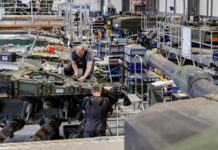![]() A new company established today in Israel will produce carbon nanotube fibre for the enhancement of body armor and composite armour systems for vehicles. The new material is stronger than Kevlar and other ballistic fabrics, but still flexible and lightweight. TorTech Nano Fibers Ltd. The company is a joint venture company owned by Israel’s world leading armor and survivability company Plasan and University of Cambridge spin-out company Q-Flo. According to the agreement, Plasan will have exclusive sales and marketing rights to defence-orientated materials, whilst Q-Flo will retain rights for other potential applications.
A new company established today in Israel will produce carbon nanotube fibre for the enhancement of body armor and composite armour systems for vehicles. The new material is stronger than Kevlar and other ballistic fabrics, but still flexible and lightweight. TorTech Nano Fibers Ltd. The company is a joint venture company owned by Israel’s world leading armor and survivability company Plasan and University of Cambridge spin-out company Q-Flo. According to the agreement, Plasan will have exclusive sales and marketing rights to defence-orientated materials, whilst Q-Flo will retain rights for other potential applications.
“We believe Q-Flo’s carbon nanotubes have the potential to revolutionise the defence industry through a new range of lightweight, flexible and incredibly strong armored material” Said CEO of Plasan Group, Dan Ziv. “Through TorTech, we intend to produce a carbon nanotube-based yarn, which can be woven into the strongest-ever man-made material. Plasan’s expertise will then enable the design and production of a revolutionary new range of body and vehicle armor” said According to Q-Flo’s CEO, Dr. Dai Hayward.
This is the first time the technology will be scaled up for industrial production. The current process for making the fibre is only capable of turning out one gram per day.
Prof Alan Windle and Dr Martin Pick, who spun out Q-Flo in 2004, developed a process that winds fibre from an ‘elastic smoke’ consisting of floating carbon nanotubes. The smoke is created by growing carbon nanotubes on tiny floating iron catalysts inside a reactor. The floating nanotubes entangle, and create an ‘elastic smoke’. This smoke can then be wound up into a continuous fibre using Q-Flo’s specially designed machine. The fibre is so thin that it is barely visible to the naked eye.
It is believed the fibre could be used to make ropes, cables, fabric and composite materials, as well as body armor. While the material’s axial strength and stiffness is in the range of conventional carbon fibre, its toughness exceeds Kevlar by three times. At the same time it is also lighter in weight. Its yarn-like nature also means that it can be successfully woven into the matrix resin of composites.
















